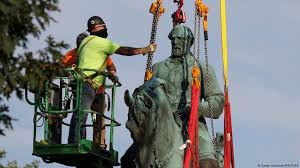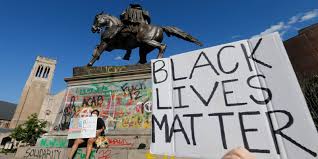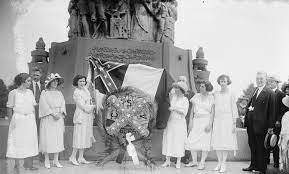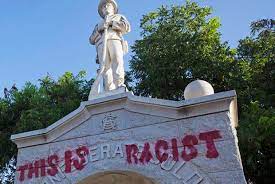|
Last month the city of Charlottesville, Virginia removed the statues of Confederate Generals Robert E. Lee and Stonewall Jackson from public parks after four years of court battles and public protests. White nationalists gathered in Charlottesville in August of 2017 for the “Unite the Right” rally to protest the removal of the Robert E. Lee statue. The rally turned violent, leading to the death of one counter-protestor. In the aftermath of the protests against racism and police brutality following the deaths of George Floyd and Breonna Taylor, there have been renewed calls across the country to remove Confederate statues and monuments. According to the Southern Poverty Law Center, over 160 Confederate statues have been removed, or toppled, since the death of George Floyd. But 1600 statues, monuments and other symbols of the Confederacy remain(https://www.splcenter.org/presscenter/splc-reports-over-160-confederate-symbols-removed-2020). Some will argue that Confederate monuments glorify a racist ideology and must be removed, while others argue that their removal is an attempt to erase or re-write history. What should be done with these monuments to preserve the historic record while promoting race relations and eliminating symbols of hate from our public places? There is little chance that a consensus will be reached anytime soon on such a contentious issue. But the United States is not alone in confronting its dark past, so maybe there are lessons to be learned from other countries. Historical Perspective: Statues and monuments on public display are visible symbols of what a society values and those who exemplify those values. They commemorate important events, venerated leaders, and memorialize those lost serving our country. Monuments remind us of the sacrifices made by others, and provide an historic link to our past. Most public monuments are noncontroversial because they memorialized the values of the majority of citizens when they were erected, and those values stand to this day. But that was not the case with Confederate monuments built after the Civil War. According to the American Historical Association ( https://www.historians.org/news-and-advocacy/aha-advocacy/aha-statement-on-confederate-monuments), most Confederate monuments were not built in the immediate aftermath of the Civil War, but from the close of the 19th century into the second decade of the 20th . There was a concerted effort by the “Daughters of the Confederacy”, White Southern politicians, and other groups to restore the reputation of the Confederacy, and to promote their racist views. It is no accident that the South after Reconstruction managed to enact racist laws (Jim Crow laws) which led to mandated segregation and widespread disenfranchisement of African Americans. The Southern Poverty Law Center goes as far as stating that Confederate monuments glorified the old South and was part of an organized campaign to terrorize African American communities. The commemoration of Confederate monuments during the mid-20th century coincided with the Civil Rights Movement, something that was strongly opposed by the Southern states. Removal is Not Erasing History: Removing Confederate monuments from public places is in no means an attempt to erase history. A monument is not history itself; it commemorates an aspect of history that the sponsors chose. It is more important than ever that we learn from our history, not erase it, in order to understand the roots of racism. The removal of a Confederate statue or monument is a civic statement that hatred and bigotry are no longer to be tolerated, and those represented no longer deserve an honored place in our society. But doesn’t this create a slippery slope? Shouldn’t we remove statues and memorials to George Washington and Thomas Jefferson, both of whom owned slaves? Reasonable people will differ on this, but I don’t believe so. There is a huge difference between our Founding Fathers who owned slaves and the Confederates who attempted to tear this country apart in order to preserve slavery. The Founding Fathers fought and died to build this country, and understood that slavery was a flawed institution that would not last. Preserving History: Destroying a piece of public property because you find it offensive is vandalism, which I do not condone. Vandalizing Confederate statues does more to promote divisiveness than it does to promote healing. Confederate memorials are artifacts of their time and place, and should be preserved just like any other historic artifact. There should be a process in place to properly document and remove statues and memorials from public places. Prior to removal they should be photographed, measured, and documented in their original contexts. Most Confederate memorials which have been taken down now sit in storage awaiting final disposition. What to do With Confederate Memorials: I believe that all monuments and symbols that glorify the Confederacy or its leaders should be removed from public places. The Confederacy is a symbol of racist ideology, and any memorials to it do not deserve a place of honor in the public squares of America. Its leaders nearly destroyed this country, and the Confederate flag is used by white nationalists as a symbol of hate. But Confederate memorials should not be destroyed. They should be preserved in such a way that the context in which they emerged will not be lost to future generations. Memorial parks and museums in other countries exist to preserve monuments to their dark pasts without glorifying them. You won’t find any public memorials or shrines to Adolf Hitler or Nazism in Germany. It’s against the law. Statues of facist leaders Mussolini and Francisco Franco are no longer on public display in Italy and Spain. You would be hard pressed to find a statue of Lenin or Stalin in most of the former Soviet block countries. So, what should the United States do with its statues to Confederate “heroes” without ignoring the past that they represent? One way would be to create memorial parks and place the statues in historic context like has been done in Hungry, India, Lithuania and Russia. Momento Park near Budapest, Hungry was built after the fall of the Soviet Union and displays dozens of statues of Communist leaders. The exhibition hall is built to look like an internment camp for political prisoners, and teaches about democracy and dictatorship. The Muzoen Park of Arts outside of Moscow displays more than 700 statues of former Soviet leaders. Coronation Park in India was built after independence from Britain. It is the resting place for statues of British monarchs and colonial overlords. Grutas Park in Lithuania is a sculpture garden of Soviet era statues and ideologic relics. It was designed to preserve the statues and showcase the country’s Soviet era past in a family friendly atmosphere. These parks, and many museums around the world, help to put offensive statuary and monuments into proper historic perspective. They also provide a way for future generations to learn from the past. These historic parks may provide a model for the United States to preserve its Confederate artifacts and put them into historical perspective for current and future generations. This could be accomplished at the state level where the statues and monuments currently preside, or through a national park or museum, possibly in collaboration with the Smithsonian. Removing polarizing pubic displays such as Confederate memorials will not resolve racial tensions in this country, but it should help. Shining a light on our dark past is an important path forward. Confederate monuments were erected to glorify a racist way of life that no longer exists, and they served to suppress a population that had no say in their construction. Confederate memorials should be methodically removed from their public places of honor and placed in museums along with a true accounting of how they came into existence. The issue of what to do with memorials to historic figures that have fallen out of favor is a big one, and I have only scratched the surface. Statues of Christopher Columbus have been removed from many public places across the country. In California statues of Father Junipero Serra, who developed the California mission system, are now coming down. Schools and public buildings are being re-named because their namesakes have somehow offended some segment of society. Sports teams are being re-named because they contain images or words that are considered racial slurs. I think some of this has gone too far. This might be the topic of a future blog.
If you enjoy reading this type of commentary please subscribe to my blog and tell a friend. You will receive an email notification when new blogs are posted. The email will come from the site’s email: armchairamerican1776 @gmail.com. Thanks, Armchair American
1 Comment
KELLY LOPEZ
8/17/2021 11:42:01 am
Thank you!
Reply
Leave a Reply. |
AuthorThe Armchair American. Archives
November 2024
Categories
All
|













 RSS Feed
RSS Feed